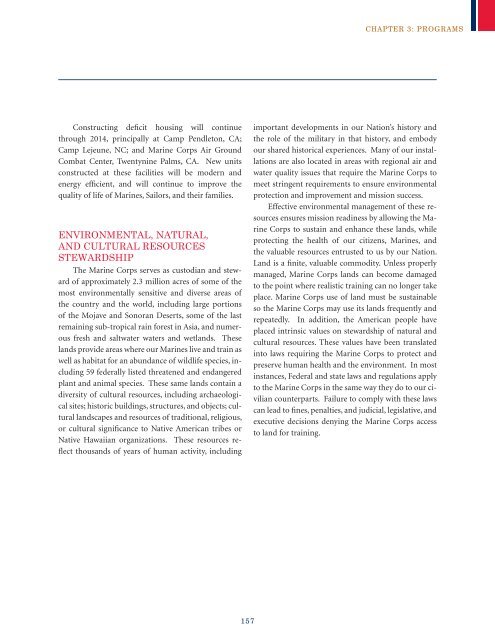USMC Concepts & Programs 2013 - Defense Innovation Marketplace
USMC Concepts & Programs 2013 - Defense Innovation Marketplace
USMC Concepts & Programs 2013 - Defense Innovation Marketplace
You also want an ePaper? Increase the reach of your titles
YUMPU automatically turns print PDFs into web optimized ePapers that Google loves.
chapter 3: programs<br />
Constructing deficit housing will continue<br />
through 2014, principally at Camp Pendleton, CA;<br />
Camp Lejeune, NC; and Marine Corps Air Ground<br />
Combat Center, Twentynine Palms, CA. New units<br />
constructed at these facilities will be modern and<br />
energy efficient, and will continue to improve the<br />
quality of life of Marines, Sailors, and their families.<br />
Environmental, Natural,<br />
and Cultural Resources<br />
Stewardship<br />
The Marine Corps serves as custodian and steward<br />
of approximately 2.3 million acres of some of the<br />
most environmentally sensitive and diverse areas of<br />
the country and the world, including large portions<br />
of the Mojave and Sonoran Deserts, some of the last<br />
remaining sub-tropical rain forest in Asia, and numerous<br />
fresh and saltwater waters and wetlands. These<br />
lands provide areas where our Marines live and train as<br />
well as habitat for an abundance of wildlife species, including<br />
59 federally listed threatened and endangered<br />
plant and animal species. These same lands contain a<br />
diversity of cultural resources, including archaeological<br />
sites; historic buildings, structures, and objects; cultural<br />
landscapes and resources of traditional, religious,<br />
or cultural significance to Native American tribes or<br />
Native Hawaiian organizations. These resources reflect<br />
thousands of years of human activity, including<br />
important developments in our Nation’s history and<br />
the role of the military in that history, and embody<br />
our shared historical experiences. Many of our installations<br />
are also located in areas with regional air and<br />
water quality issues that require the Marine Corps to<br />
meet stringent requirements to ensure environmental<br />
protection and improvement and mission success.<br />
Effective environmental management of these resources<br />
ensures mission readiness by allowing the Marine<br />
Corps to sustain and enhance these lands, while<br />
protecting the health of our citizens, Marines, and<br />
the valuable resources entrusted to us by our Nation.<br />
Land is a finite, valuable commodity. Unless properly<br />
managed, Marine Corps lands can become damaged<br />
to the point where realistic training can no longer take<br />
place. Marine Corps use of land must be sustainable<br />
so the Marine Corps may use its lands frequently and<br />
repeatedly. In addition, the American people have<br />
placed intrinsic values on stewardship of natural and<br />
cultural resources. These values have been translated<br />
into laws requiring the Marine Corps to protect and<br />
preserve human health and the environment. In most<br />
instances, Federal and state laws and regulations apply<br />
to the Marine Corps in the same way they do to our civilian<br />
counterparts. Failure to comply with these laws<br />
can lead to fines, penalties, and judicial, legislative, and<br />
executive decisions denying the Marine Corps access<br />
to land for training.<br />
157

















